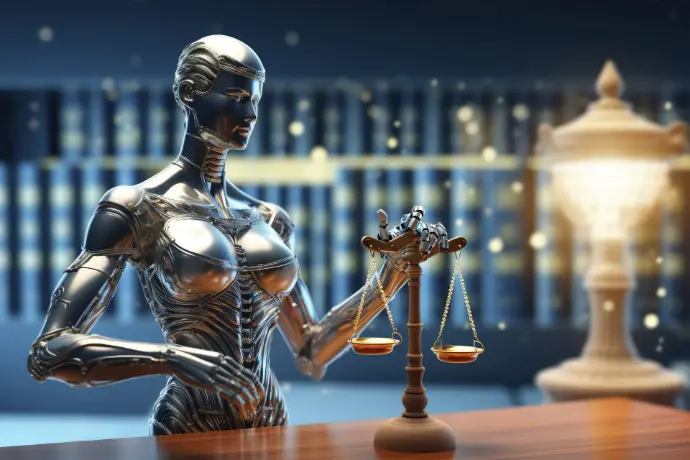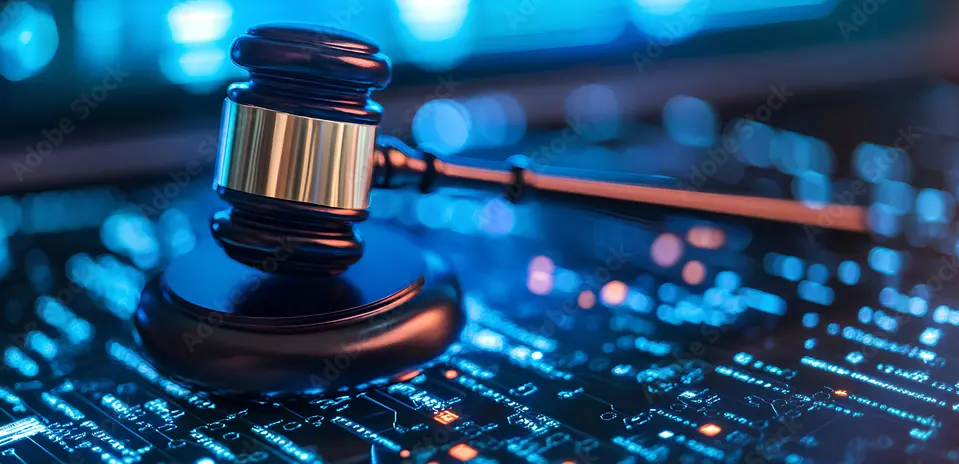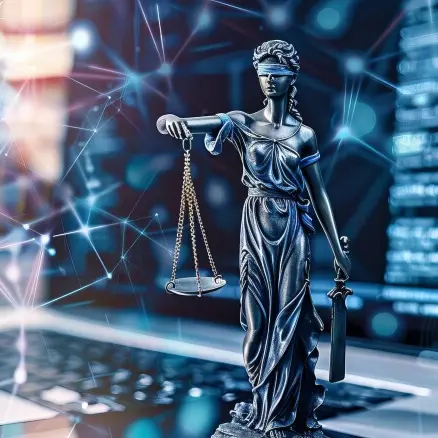Artificial Intelligence and Justice: Is the Algorithmic Judge Impartial?




In this article, you'll delve into the fascinating world of artificial intelligence and its astonishing advances. Join us as we examine the wonders and challenges presented by new technologies. In our main article, "Artificial Intelligence and Justice: Is the Algorithmic Judge Impartial?" you'll discover how the objectivity of the algorithmic judge generates intense debate. Join us on this journey into the technological future!
Introduction
Artificial intelligence (AI) has transformed many aspects of society, including the legal system. The adoption of algorithms and systems that leverage AI has significantly improved the efficiency of case management, evidence analysis, and the projection of legal outcomes. However, this technological advancement also raises questions about the impartiality of judicial decisions.
The use of algorithms for decision-making can raise concerns about potential bias and discrimination because these systems rely on historical data that may contain biases present in society. For this reason, it is essential to carefully assess how AI impacts the judicial system and ensure that impartiality is maintained throughout legal proceedings.
Furthermore, the incorporation of AI into the judicial field presents important ethical dilemmas that must be addressed carefully and thoughtfully to ensure fairness and justice are respected within the legal system.
Impartiality in judicial decision-making is a key principle that ensures fairness and justice in a legal system. Impartiality means that judicial decisions are based on the law and equity, without external influences or biases. In the context of artificial intelligence, impartiality becomes even more important, as the algorithms used to make decisions can be affected by hidden biases in the data used to train them.
It is essential that systems using AI be designed and strictly monitored to ensure that the judicial decisions they issue are fair and equitable. Transparency in how these algorithms operate, as well as constant evaluation of their performance in terms of impartiality, are essential elements for maintaining trust in the judicial system.
The issue of the impartiality of algorithmic judges is at the center of current debates and reflections, as the incorporation of artificial intelligence into the judicial system raises ethical dilemmas that must be addressed carefully and responsibly.
The application of algorithms in the judicial system presents several ethical issues that must be carefully considered. One of the most prominent issues is the possibility that algorithms reproduce and maintain biases that already exist in society, which could lead to judicial decisions that are unfair or discriminatory.
Furthermore, the lack of clarity regarding how algorithms operate in the justice system raises questions about accountability if incorrect decisions are made. Difficulty understanding how algorithms arrive at certain conclusions can undermine trust in the justice system and raise doubts about the fairness of decisions made.
It is essential that those who design and deploy algorithms in the justice system recognize and address these ethical issues early. Continuous evaluation of algorithms, as well as the inclusion of methods to correct biases and increase transparency in their operation, are vital steps to reducing the ethical risks associated with artificial intelligence in the justice sector.
What does the objectivity of the algorithmic judge mean?
Objectivity in the judicial field refers to the ability of judges and the justice system to make decisions fairly, without being influenced by personal, political, or social value judgments. Impartiality is key to ensuring fairness and equity in legal proceedings, as decisions must be based on the evidence presented and an objective interpretation of the law, avoiding any type of favoritism or discrimination.
In the context of artificial intelligence, the impartiality of the algorithmic judge implies that the algorithms used in the judicial system are capable of making decisions fairly and without prejudice, preventing any type of bias or discrimination. Since AI algorithms can impact critical decisions, such as criminal sentences or legal rulings, it is vital that they be designed and implemented objectively to ensure fairness in judicial proceedings. The issue of the impartiality of algorithmic judges is gaining relevance in the areas of ethics and artificial intelligence, as it raises challenges and concerns about how fairness can be maintained in an environment where decisions are increasingly influenced by automated systems.

Today, artificial intelligence algorithms are used in the judicial system for a variety of functions, ranging from assessing the risk of criminal recidivism to sentencing and rulings in civil cases. These algorithms rely on the analysis of large amounts of data to recognize patterns and make decisions that, in theory, should be fair and evidence-based.
However, the use of algorithms in the judicial system has raised significant concerns about impartiality and fairness. Cases have been documented in which algorithms have reflected racial or gender biases, resulting in unfair and discriminatory decisions. These issues raise significant questions about how to ensure that the algorithms used in the judicial system are truly fair and equitable.
Furthermore, the lack of clarity about how some algorithms used in the judicial system operate can complicate the assessment of their objectivity and the detection of potential biases. Opacity in how certain algorithms make decisions can undermine trust in the judicial system and cause uncertainty about the fairness of legal proceedings.
In the field of artificial intelligence, fairness refers to how algorithmic systems can make decisions fairly, without discriminating against individuals or groups based on factors such as ethnicity, gender, sexual orientation, or political beliefs. Achieving fairness in artificial intelligence is a complicated challenge, as algorithms are developed using past data that may reveal prejudices and inequalities present in society.
To improve fairness in artificial intelligence, it is essential to use methods and approaches that reduce the incorporation of bias into algorithms. This may include frequently reviewing algorithms to detect potential biases, creating datasets that are balanced and representative, and incorporating fairness and justice mechanisms into the development of these algorithms.
Furthermore, it is key to foster clarity in the creation and use of artificial intelligence algorithms so that the decisions made are understandable and auditable. Clarity helps ensure accountability and allows biases or unfair decisions to be identified and addressed.
Neutrality is a crucial aspect of the legal system, and the use of artificial intelligence raises the question of how to ensure that the algorithms used to make legal decisions are truly fair. Although algorithms rely on data and calculations, fairness is not automatically guaranteed because biases can exist in the data used to train artificial intelligence models. Therefore, the fairness of an algorithm relies heavily on the quality and representativeness of the data it is provided with.
Algorithms can inadvertently adopt biases from historical data, which can lead to unfair or discriminatory decisions. For example, if a crime detection algorithm is trained with data that reflects bias in law enforcement, such as the overpolicing of certain communities, the algorithm is likely to produce biased decisions. Thus, the fairness of an algorithm is not something that happens on its own; rather, it is a goal that requires careful attention and specific actions to reduce inherent biases.
To address the issue of fairness in algorithms, it is essential to establish transparency and auditing practices that facilitate the detection and correction of potential biases. This can include reviewing the data used, constantly evaluating the decisions made by the algorithm, and implementing systems that ensure fairness in decision-making. Although achieving complete fairness can be complicated, combining ethical, technical, and legal methods can help develop fairer and more equitable algorithms.
Challenges to Impartiality in the Algorithmic Judge
The use of algorithms in justice presents significant challenges regarding impartiality. One of the most notable aspects relates to the biases that may be present in the data used to train these algorithms, which can affect legal decisions. It is vital to understand how these biases can affect the fairness of the algorithmic judge.
Biases in the data used by judicial algorithms can originate from various sources, such as historical records that show biases or discrimination that have existed in the justice system. This represents a major challenge, as algorithms often learn from this historical data and therefore repeat biased patterns in their decisions. Addressing this problem is essential to ensure the impartiality of the algorithmic judge.
Furthermore, a lack of clarity in how data is collected and selected can create unintentional biases that compromise the impartiality of the algorithmic judge. The lack of transparency in this procedure makes it difficult to identify and correct potential biases, which constitutes a considerable challenge in the goal of achieving impartiality in automated judicial decision-making.

Identifying and correcting algorithmic biases in the judicial field faces significant challenges, given that the complexity of algorithms makes it difficult to correctly identify potential biases. The lack of clarity about how algorithms make certain decisions, coupled with the lack of effective tools to correct biases once they are identified, complicates the task of ensuring the fairness of the algorithmic judge.
Furthermore, the dynamic nature of data and changes in social contexts can give rise to new biases that have not been previously detected. The ability of algorithms to adjust to these rapid changes adds another challenge to the identification and correction of algorithmic biases, which directly impacts the impartiality of the automated judicial system.
It is essential to develop more effective methods to continuously and early identify and correct algorithmic biases to reduce the negative impact on the impartiality of algorithmic judges. This task presents a significant challenge that requires the collaboration of specialists in ethics, artificial intelligence, and law to ensure that judicial algorithms are as fair as possible.
A key strategy for addressing the impartiality of algorithmic judges is to integrate human interpretation into the automated decision-making process. While algorithms can provide objective data-driven analysis, human intervention can offer essential contextualization and nuanced understanding that algorithms might not capture.
Involving humans in monitoring and evaluating decisions made by algorithms in the court system can be very helpful in reducing bias and ensuring procedural fairness. This collaboration between artificial intelligence and human intervention presents a promising strategy for addressing impartiality issues in the automated judicial system, facilitating fairer and more balanced decision-making.
The objectivity of algorithm-based judges faces significant challenges due to data biases, limitations in identifying and correcting algorithmic biases, and the vital role of human interpretation in the proceedings. Addressing these issues is key to ensuring that the implementation of artificial intelligence in the judicial system promotes justice and equity.
Ethics and Responsibility in the Implementation of Artificial Intelligence in the Judicial System
The use of algorithms in the judicial decision-making process raises important ethical issues that must be treated seriously. One of the greatest challenges is ensuring that the algorithms are fair and equitable in their judgments. The creation of these algorithms must include a thorough analysis of potential biases, both in the data used to train them and in their operational logic.
It is vital to reflect on how fairness is understood in the judicial field and how it can be expressed in algorithmic terms. This not only entails eliminating overt bias but also ensuring the fair application of the law among different social and demographic groups. Artificial intelligence engineers and developers must collaborate closely with ethicists and legal experts to ensure that judicial algorithms adhere to the basic principles of justice and equity.
Ethical reflection in the creation of judicial algorithms is essential to prevent unintended outcomes and to establish a legal system that promotes public confidence in its impartiality.
Creators of artificial intelligence have an obligation to ensure that the algorithmic judge remains impartial. This requires not only the creation of technical measures to detect and reduce bias, but also the adoption of approaches that promote fairness and justice in the development and implementation of these systems.
It is essential that AI developers understand the significant influence their products can have on society and, specifically, on the judicial system. Including diversity in work teams and integrating different perspectives are essential to recognizing potential biases and designing judicial algorithms that reflect the ethical and moral principles of justice.
Furthermore, full documentation of how design decisions are made and a willingness to be held accountable for any issues with impartiality are key aspects of the responsibility of AI creators. Transparency in the development process and a willingness to adjust and improve algorithms based on ongoing feedback and evaluation are foundations of ethical responsibility in this area.
Clarity in the algorithm-driven decision-making process is crucial to ensure that the algorithmic judge acts fairly. Citizens need to understand the use of algorithms in the judicial system and their impact on decisions that affect them. A lack of clarity about how these algorithms work can erode trust in the judicial system and raise questions about the fairness of its procedures.
Therefore, it is essential that judicial bodies and those developing artificial intelligence strive to provide simple explanations of how algorithms operate in judicial decision-making. Being responsible in the use of algorithms in the justice system not only involves showing the rationale behind them, but also being willing to review and modify these algorithms if biases or unfavorable results are detected.
Clarity and accountability are key aspects to increasing confidence in the impartiality of the algorithmic judge and ensuring that the application of artificial intelligence in justice adheres to fundamental ethical and legal principles.
When applying artificial intelligence in the justice system, it is essential to consider the role of human oversight in automated judicial processes. Although algorithms can handle large volumes of data and assist in decision-making, human intervention is necessary to ensure fairness and ethics in the system. Human oversight allows biases to be identified, details to be interpreted, and exceptional situations to be considered that an algorithm might not be able to capture.
Furthermore, human intervention is vital to defining the parameters and standards that govern how algorithms operate in automated judicial processes. It is the task of legal and ethics specialists to ensure that algorithms are configured to reflect key values such as fairness, impartiality, and respect for human rights. Likewise, human oversight must be in place to assess and correct potential errors or unfair decisions that may arise from the use of artificial intelligence in the judicial system.
Human oversight is a fundamental element in the creation and use of automated judicial systems that incorporate artificial intelligence. Their participation ensures that ethical and moral values are always present in decisions, thus supporting the pursuit of justice and impartiality when implementing new technologies in the legal field.
The Future of Fairness in Artificial Intelligence in the Judiciary
The adoption of artificial intelligence within the judicial system has raised important questions about the impartiality of the algorithms used to make selections. As progress is made in this field, it is essential to examine the progress made in reducing algorithmic biases within the judicial system, seeking to ensure fairness and equity in legal proceedings.
Advances in reducing algorithmic biases in the judicial system have gained importance in the pursuit of impartiality in the algorithmic judge. Several researchers and specialists in artificial intelligence have dedicated efforts to developing algorithms that can detect and reduce innate biases, such as those related to gender, ethnicity, or social class, which could affect judicial decisions. These achievements mark important progress toward creating more fair and equitable systems.
Through the application of advanced machine learning techniques and the analysis of extensive databases, bias patterns have been identified, and more fair-focused algorithms have been created. Measures such as data disaggregation, continuous algorithm review, and transparency in decision-making have been implemented to effectively address the reduction of algorithmic biases in the judicial system.
These developments are an essential milestone on the path toward impartiality in algorithmic judges, helping to build a fairer and more equitable judicial system for all citizens.
Despite notable advances in reducing algorithmic biases, significant challenges remain in the pursuit of impartiality in algorithmic judges. One of the most significant challenges is the difficulty in defining and measuring impartiality in the field of judicial artificial intelligence. Impartiality is not a fixed concept but varies depending on interpretations and ethical and social considerations.
Furthermore, constant technological evolution and the emergence of new bias factors create ongoing challenges in the pursuit of impartiality in algorithmic judging. It is crucial to address the complexity of these issues through collaboration between ethics, law, artificial intelligence, and data science professionals.
The ability to understand and reduce algorithmic biases in the justice system will continue to be a vital area of research and development in the pursuit of impartiality in algorithmic judging.
In the field of the ethics of artificial intelligence in justice, education and awareness are essential to ensure that algorithmic judging acts fairly. A clear understanding of ethical principles and the potential effects of artificial intelligence on the justice system is critical, both for lawyers and for society as a whole. Training in the ethics of artificial intelligence in justice should include not only technical and legal issues, but also the social and ethical implications of using algorithms in judicial decision-making. Raising awareness about the crucial role of maintaining impartiality and fairness in artificial intelligence in justice will help increase accountability and transparency in the creation and use of these systems.
Furthermore, joining forces between universities, government agencies, and civil society can help establish ethical standards and best practices for the application of artificial intelligence in justice, which in turn will strengthen confidence in the impartiality of the algorithmic judge.
Conclusions
Neutrality within the judicial system is a key element in ensuring justice and fairness. With the advent of artificial intelligence in legal decision-making, it is urgent to examine the neutrality of the algorithms used. The neutrality of the algorithmic judge is of utmost importance, as automated decisions can be affected by unintentional biases arising from training data or algorithm design.
It is essential that creators of artificial intelligence systems in the judicial field focus on developing algorithms that are neutral and do not discriminate based on gender, race, sexual orientation, or any other personal characteristic. Likewise, it is the duty of regulatory bodies and institutions within the judicial system to be vigilant about the use of artificial intelligence in this field, ensuring that the highest levels of fairness and neutrality are respected.
Addressing neutrality in judicial artificial intelligence is not only an ethical issue, but vital to maintaining trust in the judicial system and protecting people's fundamental rights.
Automating judicial processes through artificial intelligence promises to improve the speed and efficiency of case resolution. However, it is very important to strike a balance between efficiency and neutrality when implementing these technologies. Efficiency must not compromise neutrality, as justice must be paramount.
When deploying artificial intelligence systems in the judicial field, it is crucial to conduct rigorous neutrality assessments and establish methods to correct algorithmic biases. Transparency in how these systems operate is also essential to ensure that automated decisions are clear and can be challenged if necessary.
The balance between efficiency and neutrality in judicial automation is a challenge that requires careful attention and an approach that integrates specialists in ethics, law, artificial intelligence, and data analytics.
The disinterestedness of the algorithmic judge presents great complexity and importance in the current context of the judicial system. Although artificial intelligence can offer significant benefits in terms of efficiency and resource optimization, it is essential that it not affect neutrality and fairness in the application of justice.
Ethical and legal issues related to the neutrality of algorithm-based judges must be addressed carefully and precisely. It is essential to create clear regulations that specify the neutrality criteria that artificial intelligence systems must follow in the judicial field, as well as to establish oversight and accountability mechanisms to ensure their correct application.
Ultimately, the goal must be the creation and use of artificial intelligence systems in the judicial field that serve as useful tools for human judges, supporting the decision-making process, but without replacing human judgment or jeopardizing impartiality and fairness.

 IHRO NEWS
IHRO NEWS